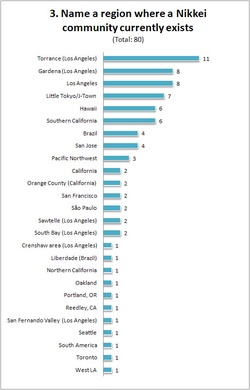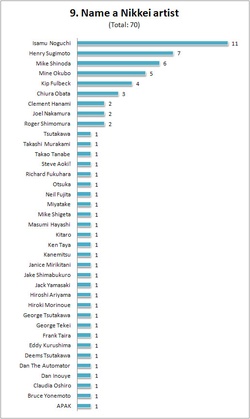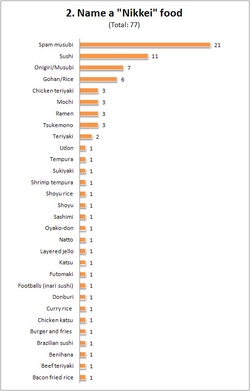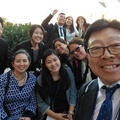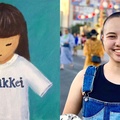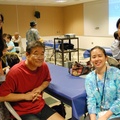We’ve been “testing” out something this year at Discover Nikkei. It’s a Family Feud-type survey game. The first couple of times I ran around asking co-workers, volunteers, and friends to answer a couple of questions. The last time we did it, we decided to post the questions online. Between October 30 and November 19, 2010, there were 80 people who responded.
There were 12 questions, although not everyone answered each one. Yoko Nishimura (Discover Nikkei’s Project Coordinator) and I would excitedly check every day for new responses. As people began filling out the survey, we would discuss some of the very interesting patterns that emerged.
We didn’t ask for any identifying information, so the results were anonymous (although we were able to figure out which sets of answers belonged to some of our co-workers and friends). Even though in most cases we didn’t know who was answering the survey, there were several questions that demonstrated very regional responses, particularly indicating that the majority of the responses were from Southern California.
The most obvious indicator was “Name a region where a Nikkei community currently exists” whose top 4 answers—Torrance (11), Los Angeles (8), Gardena (8), and Little Tokyo/J-town (7) are all within Los Angeles County. Of the 80 responses to this question, 49 were Southern California-based responses. 11 more were from other California (primarily the Bay Area), 11 others were from other parts of the United States (mostly Pacific Northwest), and the remaining 9 answers were for non-U.S. locations, primarily in Brazil.
Of the 75 responses to “Name a Nikkei community newspaper,” 54 were for the Los Angeles-based Rafu Shimpo, which correlates to the large percentage of Southern California responses. The second-highest answer was the North American Post in Seattle, WA with 3 responses. Also included were publications in San Francisco, Honolulu, Chicago, New York, Portland, Toronto, and Argentina. Some of them are no longer in print. [Editor’s note: Discover Nikkei is currently working on a project and public program scheduled for April 2, 2011 about this topic.]
Similarly, “Name a Nikkei politician,” had one primary answer—50 of 70 answered Senator Daniel Inouye (he won the recent Senate elections in Hawai‘i this past November by about the same margin!). The next highest answers were Norman Mineta (5) and Mike Honda (4). There were only 12 different people named in total, with about half now either deceased (Patsy Mink, Robert Matsui, Spark Matsunaga) or not currently holding office (Norman Mineta, George Ariyoshi). This could be partly because of the enormous popularity and fame of Senator Inouye, but also points to a lack of other significant Nikkei leaders in politics.
“Name a Nikkei organization in the U.S.” had 78 responses, with 23 different organizations named. The most popular answers were: JACL (30), JANM (16), and JACCC (6). Beyond the top organizations with national reach, the responses were primarily regional with some variations in the type of groups including sports organizations, community centers, Daruma no gakko (a Japanese American heritage summer school program), the Nikkei Credit Union, the Tule Lake Committee, and a Boy Scout Troop. There were even 3 responses for Discover Nikkei!
Another regional indicator was the question “Name a Nikkei taiko group.” This question had the least number of total responses (67), but 32 different taiko groups represented. About half of the responses (34) were for Southern California-based groups and another 13 from Northern California, including the top 3 responses—Zendeko (8), San Jose Taiko (8), and TAIKOPROJECT (7). There were some groups that seemed to be named because of their general popularity, not just because of regional familiarity. There were more selections for San Jose Taiko, TAIKOPROJECT, and Kenny Endo Taiko than correlated to other regional responses.
The two other questions that people seemed to struggle with were “Name a Nikkei artist” and “Name a Japanese American author.” There were 70 responses to the artist question, with the most popular answer being Isamu Noguchi (11), followed by Henry Sugimoto (7), Mike Shinoda (6), and Miné Okubo (5). Interestingly, the next artist on the list was Kip Fulbeck (4), who is part Chinese, but has collaborated with the Japanese American National Museum on two exhibitions on mixed race identity. We also have clips from an interview with him about the topic on Discover Nikkei. There were 37 different names listed, including musicians like Claudia Oshiro, an Argentine Nikkei singer in Japan, and Jake Shimabukuro, the ukelele star from Hawai‘i. I even learned about artists I didn’t know about like Neil Fujita who recently passed away in October. He was a successful graphic designer who designed the bookcover for The Godfather and the rainbow logo for NBC’s Today show.
For the Japanese American author question, we received 69 answers yielding 35 different names. The top response was Naomi Hirahara (13), followed by Allen Say (6), Gil Asakawa (5), and David Mas Masumoto (4). I recognized almost all of the names, but I did discover a new author, Anna Kazumi Stahl, a Japanese-German American from Louisiana who now lives and writes in Argentina.
There were a few questions that yielded fairly straight-forward responses. There were 80 answers to “Name a Nikkei holiday or festival” with the top answers: Obon (27), Oshogatsu/New Year (26), and Nisei Week (9). There were only 15 different answers, but there were a few surprises—Issei Day, Japanese–heritage month, and Thanksgiving.
Another was “Name a common Nikkei last name.” There were 77 responses to this question with the most popular being Tanaka (11), Murakami (11), Nakamura (10), Sato (7), Yamamoto (6), and Suzuki (6). We weren’t sure what to expect with this question. In the end, there were few surprises, except maybe that there weren’t as many different names listed as we might have thought.
Another question with a lot of common answers was “Name a Nikkei generational term.” It looks like many of the respondents (77) answered with their own generation. Although there were the predictable Nisei (20) and Issei (9) responses, the top answer was Sansei (21). Yonsei (16) was also in the top three. Interestingly, there was also Hapa (3), Gosei (1), Kibei (1), Shin Issei (1), and Shin-nisei (1). There were also some random terms like “JA basketball” and “kodomo no tame ni” which were interesting responses to a question about generational terms.
The remaining two questions from the survey generated the most interesting responses for us. All 80 people included something under “Name a ‘Nikkei’ food.” Not surprisingly, the top answers were all rice dishes—spam musubi (21), sushi (11), onigiri/musubi (7), and gohan/rice (6). The rest of the 30 responses featured predictable foods like ramen, mochi, and teriyaki, but also included bacon fried rice, Brazilian sushi, burger and fries, layered jello, and Benihana.
“Name a Japanese word that you think Nikkei use most often.” For Yoko and I, this was the most interesting of all the questions, and yielded the most surprising responses. The most popular answer was predictable—arigato, with 9 responses. From there, the answers quickly reinforced what I’ve thought for a long time…that most Japanese Americans, in Southern California at least, don’t know very much of the Japanese language. Mostly what bits and pieces they do know are food terms and words that they heard as a little kid from their parents, grandparents, and other relatives, usually as admonishments. So, what you end up with are words like baka (7), sushi (5), benjo (4), and shoyu (3).
There were so many varied responses—there were 44 different responses, more than any other question. Some of my favorites besides the ones in the top five are nani? (2), baa-chan (2), abunai (1), Bacchi (1), Maaaaaaa, neh! (1), and shishi (1). Someone even put marukai (the name of a Japanese market chain), which I found amusing, but others thought was appropriate because it was a word they heard often.
Although this survey was intended purely for entertainment purposes, the results provided us with an interesting snapshot into our communities. As happens often when I’m working on something for Discover Nikkei, I found myself learning much and gaining more than I had hoped for through this exercise.
Even working on this article, I ended up taking much longer to write than I had anticipated because the data took me on many detours as I came across names and terms I was not familiar with. Community + Nikkei-related stories & trivia = a fun way to learn. Thank you to everyone who participated in our survey!
We definitely plan to do more of these surveys in the future. Hopefully, in the future we’ll have even greater pool of responses to learn from. Help us figure out the next set of questions! Post your suggestions in the comments section below (you’ll need to log in to comment).
Download the PDF to view all of the survey results >>
© 2010 Vicky Murakami-Tsuda



